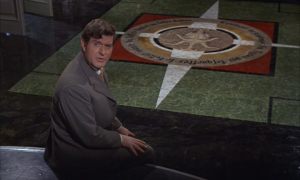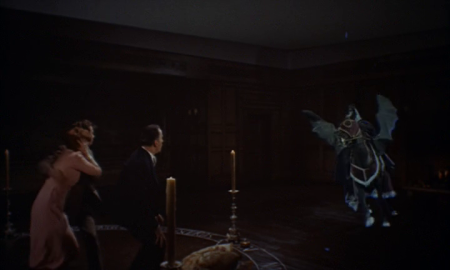We’re gonna need a bigger goat

A blogathon! How NICE! The main page is here.
Fiona first saw THE DEVIL RIDES OUT — “From the classic novel by Dennis Wheatley — on TV, while high on magic mushrooms, an experience she does not recommend. When the Duc de Richleau commands “Don’t look at his eyes!” she became entranced, hypnotised, staring at the eyes and trying to work out what was so special about them. “He’s right! They’re TERRIBLE!” she concluded, and never took mushrooms again. The other main effect of the shrooms was that nothing about the story seemed comprehensible, which might be a good thing — Dennis Wheatley’s novels are pretty basic and stodgy in terms of story, character, prose and dialogue. A dash of psychoactive substance might be just what they need.

Mind you, Hammer’s other Wheatley adaptation of 1968, THE LOST CONTINENT, based on the novel Uncharted Seas, caused my friend Danny to think he WAS on drugs, even though he wasn’t. It is completely bananas, and Wheatley’s peculiar Sargasso Sea fantasy is adapted by Hammer boss’s son Michael Carreras, who couldn’t write, didn’t know one end of a story from another, had no concept of structure… (I hate producers who give themselves writing gigs nobody else would ever hire them for.)
DEVIL is adapted by Richard Matheson, an altogether more skilled writer — and ACTUAL writer — who had recently been writing Poe films for Corman. Hammer didn’t have a terribly proactive approach to scooping up outside talent — they should have jumped at Barbara Steele, lured over Vincent Price, recruited Michael Reeves, and acquired better writers than Jimmy Sangster. When they did hire J.G. Ballard, they spelled his name wrong. But they did well to pick up Matheson, and the ever-reliable Terence Fisher.

Though maybe a more eccentric director would have worked here, for the film’s slightly psychedelic sequences. Fisher can be rather stolid, prosaic, and so can some of his actors here. In fact, Fisher does marvelous work here with scenes of waiting and suggestion, but is let down badly by the special effects and make-up and, to a lesser extent, the fight arrangements.
BUT — like Fiona, I knew this film from TV and VHS and seeing it again in the right aspect ratio and a sharper image really made it come alive.
Here’s a limerick — I should have saved it for Limerwrecks, where my doggerel usually appears, but I didn’t think of it.
The Devil Rides Out — best beware
He revels without any care
At midnight black masses
He fiddles with lassies
Disheveled and sprouting with hair.

Despite it being 1968, these are the only bare breasts displayed.
Onto the film! Christopher Lee was very keen on this one, and happy to be playing a hero — a sort of Sherlock Holmes of the supernatural, another of Hammer’s rather harsh authority figures — they idea seems to be, we’re supposed to find Van Helsing and De Richleau unsympathetic, cold and scary, but still prefer them to the licentious evil of the netherworld, which can only be safely enjoyed in movies.
In postmodern terms, the film stars Saruman, Ernst Stavro Blofeld, Captain Miles Gloriosus and Prime Minister Jim Hacker.

It’s a very linear, this-follows-that kind of narrative — when the characters branch off in separate directions, we typically stay with only one set, eschewing intercutting. Lee’s Richleau meets up with friend Rex Van Ryn (Leon Greene, but dubbed by Patrick Allen) and they set off to investigate why their friend Simon (Patrick Mower) has dropped out of circulation. Stopping by at Simon’s newly-acquired big country house, they find a gathering — supposedly an “astronomical society” — “My God!” exclaims Greene, using Allen’s voice — apparently it’s the presence of black and asian people in their native garb that shocks him so.
Lee quickly deduces that Mower has fallen into the hands of satanists, just as he would in INCENSE FOR THE DAMNED. Mower is a pushover: anything in a ceremonial robe. In this case, the cult leader is one Mocata, played with fruity relish by Charles Gray, aka The Criminologist from ROCKY HORROR. Also drawn into the madness is young Tanith, Nike Arrighi, who seems dubbed but isn’t. Maybe she had to loop her lines to match Greene/Allen’s post-synched dialogue. (Incidentally, I can’t see why Green had to be dubbed: his voice and delivery was fine in other films — he was an opera singer, in fact.)

Later on, Nike Arrighi’s voice will issue from another character’s mouth, making this a film ABOUT dubbing…
What follows is a fairly relentless series of set-pieces: two hypnotisings, some psychic attacks and summonings, a black mass (starring the Goat of Mendes) and assorted conjurations. The simpler these are, the better they tend to work. The black guy who materialises in the middle of a room, staring and grinning, is scary because he doesn’t move (also: don’t look at his eyes) ~

The Angel of Death, however, is pretty disappointing, with his horse with bat-wings pasted on. Fisher tries to make the thing dramatic by having the horse rear up in close-up, and then some idiot looped the film to make the action repeat. Slow-motion and long-shot and losing the stupid wings would have worked a lot better. Just exploit the uncanny/surreal set-up of a horse indoors: you lose that by going in close. A shame, because the whole magic circle bit was atmospheric, with the camera edging round the chalk outline, causing candles to float through frame. And Lee is marvelously authoritative.

Christopher Neame, in charge of the second unit, reports in his memoir that the Angel of Death’s horse’s wings had a tendency to fall off whenever it reared up. I think the Great God (or Devil) of Cinema was trying to tell him something.
But the melodrama of Lee’s exposition and Gray’s bully-boy sneering is so effective that the main objection to the story — that Richleau has an amulet of incantation for every occasion, and so real menace is absent, a lack disguised by Richleau simply not telling us what he’s got planned — doesn’t occur to one, or didn’t occur to me, until after the film is over. At which point it’s too late to jump into the screen and cry, “Hang on! This is a stitch-up!” The magic spell has already been performed. Time and space have been altered.

Lost in time… and lost in space… and meaning…
June 1, 2018 at 1:01 pm
[…] tells us more on a few Hammer films including The Devil Rides Out […]
June 1, 2018 at 1:09 pm
Thanks for bringing this film and the others to our blogathon, and what a cast! Going to check out for Charles Gray and that bat-winged horse. Fantastic!
June 1, 2018 at 1:25 pm
This was released stateside as “The Devil’s Bride.” I also recall that “Cahiers du Cinema” took Fisher up as an auteur during this period (the Jean-Pierre Oudart “Suture” era which found Fritz Lang, Robert Bresson and late-period Eisenstein being talked aout in the same breath.)
June 1, 2018 at 7:19 pm
I would have thought Positif might have been a better match!
June 2, 2018 at 12:52 am
I would have thought so to but in the immortal words of Fats Waller “One never knows — do one?”
June 3, 2018 at 9:15 pm
Excellent write-up, with some cool facts behind this film. I love the title of your post, by the way! Thanks for participating in our blogathon!
June 4, 2018 at 4:09 am
The Devil Rides Out is one of my favourite Hammer Horrors, even though it does have its flaws (it really could have used better special effects). I always loved that Sir Christopher Lee got to the play the hero for a change!
June 4, 2018 at 7:32 am
My absurd, over-the-top love of Horror Express stems mainly from Lee and Cushing playing slightly antagonistic heroes: the spark of hostility is an improvement over Fisher’s Night of the Big Heat.
June 4, 2018 at 12:10 pm
The Devil Rides Out was Christopher Lee’s favorite of his films.